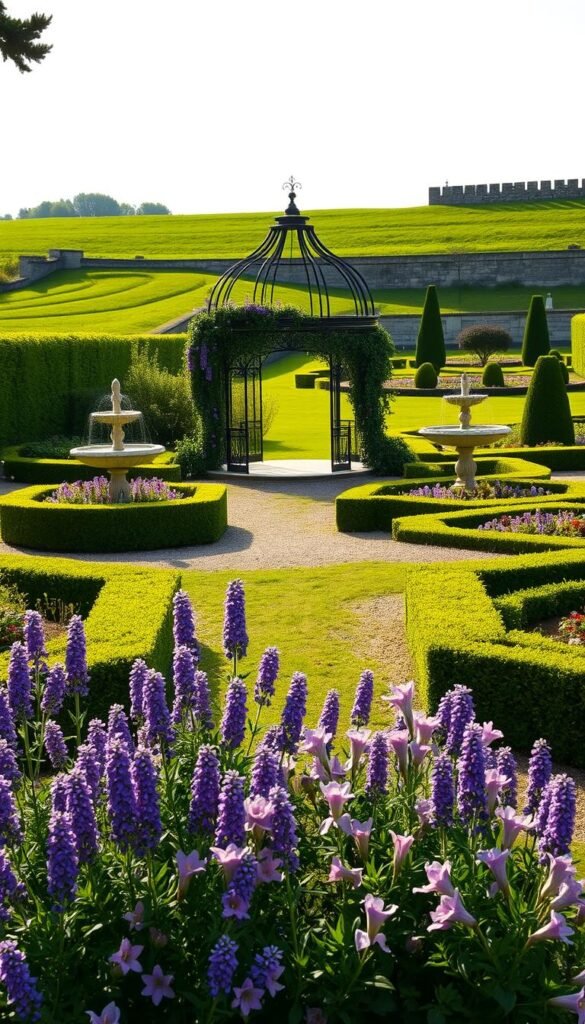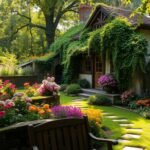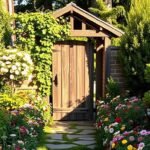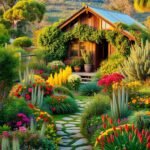Imagine stepping into a space where every path, planter, and petal feels intentionally placed. This is the magic of blending structured layouts with natural charm. A well-crafted outdoor area becomes more than just plants and pathways—it becomes a living work of art.
Symmetry plays a starring role here. Think of geometric patterns softened by blooming flowers or neatly trimmed hedges framing antique stone accents. These choices create visual harmony while honoring centuries of European horticultural traditions.
You don’t need acres of land to capture this aesthetic. Even small patios can embrace balance through strategic placement of ironwork details or terracotta pots. The goal? To merge practicality with timeless sophistication that feels both curated and inviting.
Materials matter just as much as layout. Durable stone planters and weathered metal fixtures add texture while standing up to the elements. Pair these with lush greenery for a look that ages gracefully, season after season.
At its core, this style celebrates the dance between human creativity and nature’s spontaneity. Whether you’re drawn to grand gestures or subtle touches, your space can reflect a refined yet welcoming spirit that never goes out of fashion.
Embracing the Timeless French Garden Aesthetic
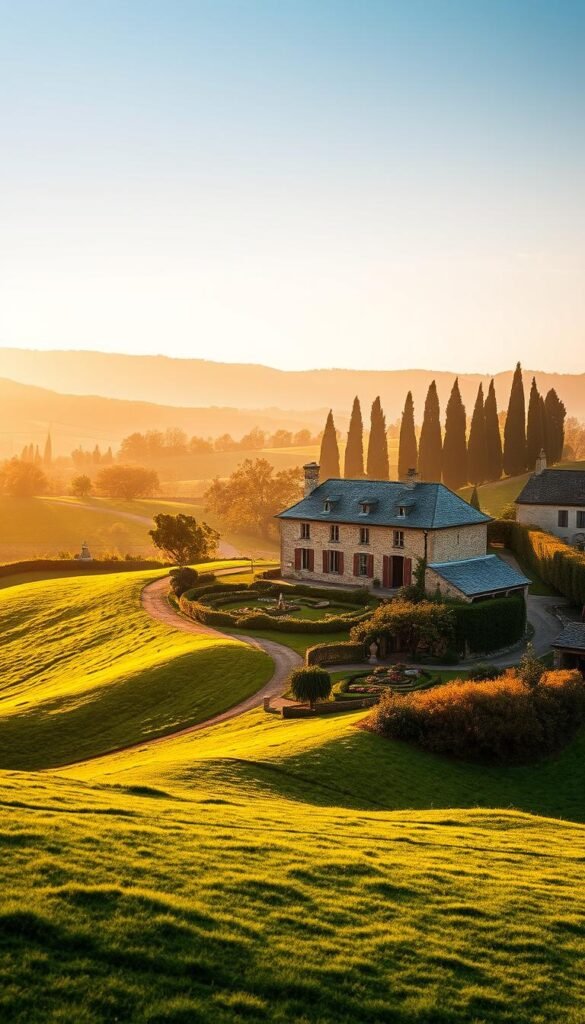
Centuries-old principles shape outdoor spaces that feel both grand and inviting. This approach to arranging greenery and structures isn’t just about looks—it’s a philosophy rooted in cultural values and artistic vision.
The Historic Charm Behind French Gardens
These spaces trace their origins to 17th-century estates like Versailles, where vast grounds became canvases for geometric storytelling. Architects used precise lines and manicured greenery to mirror classical buildings, blending nature with human ingenuity.
What started as displays of power evolved into a global influence. Today’s interpretations retain that sense of grandeur through structured layouts and curated plant choices. The goal remains unchanged: creating harmony between controlled patterns and organic growth.
What Sets This Style Apart
Three core elements define this aesthetic:
- Mathematical precision: Shapes repeat in mirror-like arrangements
- Architectural dialogue: Stone pathways echo nearby building features
- Controlled wildness: Flower beds soften rigid lines without disrupting balance
| Feature | French Approach | Other Styles |
|---|---|---|
| Layout | Central axis with mirrored sections | Asymmetrical or free-form |
| Planting | Formal hedges + seasonal blooms | Mixed perennials or wild growth |
| Materials | Weathered stone & wrought iron | Modern composites or untreated wood |
This balance of discipline and beauty makes the style adaptable yet distinctive. Whether working with sprawling yards or compact terraces, you can apply these principles to craft spaces that feel intentionally composed yet effortlessly welcoming.
Creating Symmetry and Order in Your Outdoor Space
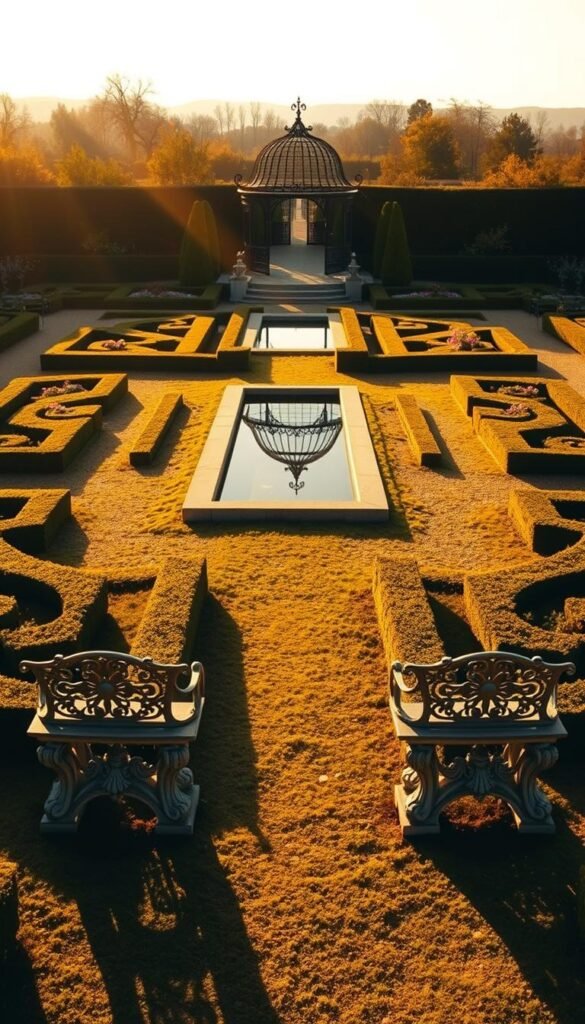
Visual balance transforms outdoor areas into serene retreats. Start by establishing a strong focal line down your space’s middle. This backbone could be a gravel walkway, twin hedge rows, or a rectangular reflecting pool.
Mastering Mirror-Image Greenery
Flank your central axis with matching flora for instant rhythm. Try pairing linden trees or lavender clusters on both sides. Geometric plant beds work beautifully here—think squares of rosemary or circular rose displays.
Keep furnishings equally distributed. Place identical benches facing each other or twin urns at pathway ends. This approach creates rhythm while maintaining functionality.
Materials tie everything together. Use the same stone for edging and pathways. Match metal finishes on lanterns and trellises. Consistency makes intentional designs feel effortless.
Nature’s variations add charm without breaking structure. Let spring bulbs bloom freely within their defined beds. Allow climbing vines to soften stone walls—controlled spontaneity keeps spaces lively yet orderly.
Incorporating Classical Elements and Antique Accents
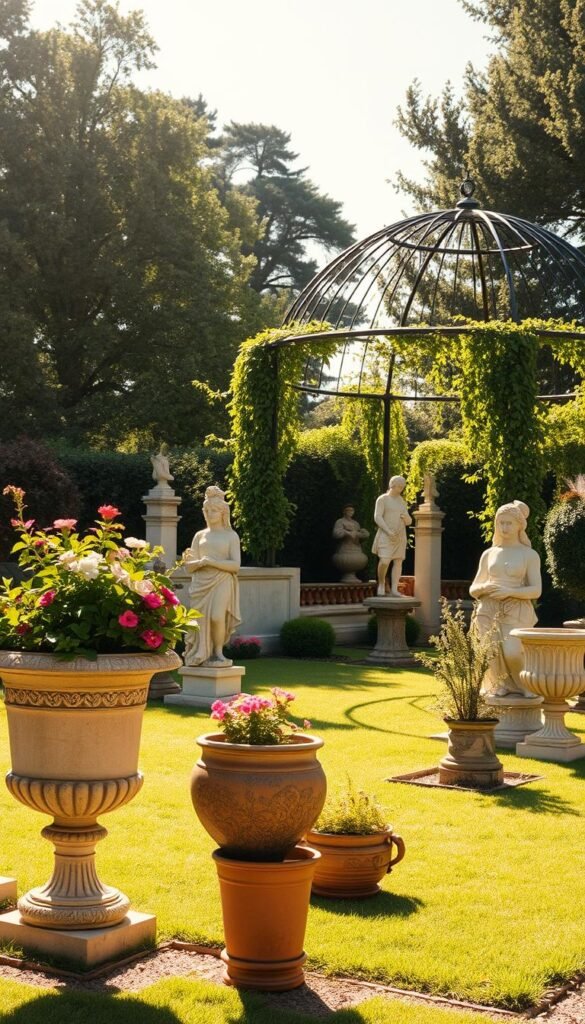
The right accents can turn any space into a gallery of living history. Aged materials and artful details create depth while honoring time-tested aesthetics.
Enhancing Your Space with Vintage Planters and Sculptures
Cast iron Medici urns bring instant refinement with their clean lines and weighty presence. These elements work equally well framing entryways or anchoring flower beds. For weathered charm, try antique planters showcasing natural patinas—each mark tells a story of craftsmanship.
Handmade Anduze urns add authentic character. Crafted since the 1700s, these terracotta treasures feature sculpted garlands and glossy glazes. Place them near seating areas or water features to draw the eye.
Mix materials for visual interest:
- Stone containers withstand harsh weather while aging gracefully
- Wrought iron stands elevate trailing plants
- Terracotta gains charm when aged using yogurt-based moss treatments
Position vintage pieces where architecture meets nature—beside gates, along paths, or under arched trellises. Let functional sculptures like birdbaths double as focal points, blending artistry with purpose.
French Garden Design Ideas: Elegance and Order in Your Outdoor Space
Precision meets creativity when sculpting outdoor areas with mathematical flair. This approach turns greenery into living architecture through strategic shaping and spatial awareness.
Key Features That Define the Timeless Look
Start with clean lines that guide the eye through your layout. Boxwood hedges cut into crisp rectangles make perfect borders for walkways. Try alternating tall and short shrubs along paths—this layered effect adds depth while keeping things tidy.
Potted evergreens offer flexibility for patios or balconies. Shape bay laurels into spheres or pyramids using sharp shears. These mobile features let you rearrange your elegance as seasons change.
Three principles ensure success:
- Repeat angular shapes in planters and pathways
- Use symmetry to create visual anchors
- Balance formal elements with loose floral textures
Even narrow yards gain grandeur with parallel hedge rows. Space them evenly and trim monthly for sharp definition. Add gravel between green walls to mimic historic promenades scaled for modern spaces.
This style thrives on contrast—pair rigid forms with billowing lavender or roses. The result? A polished yet welcoming atmosphere that feels both deliberate and alive.
Curating Iconic Plant Selections and Fragrances
![]()
Crafting a garden that captivates the senses starts with iconic flora known for their enduring charm. These botanical choices create living tapestries of color and scent while honoring horticultural traditions.
Heirloom Roses, Lavender, and Other French Classics
Pierre de Ronsard roses cascade with cabbage-like blooms in soft pinks, while Cécile Brunner’s petite flowers add delicate texture. For golden hues, Buff Beauty’s apricot-toned roses shine alongside Jacques Cartier’s rich perfume. Plant these varieties in sunny spots with well-drained soil—six hours of daily light keeps them thriving.
Lavender serves multiple roles: its purple spikes repel pests while attracting pollinators. Pair it with rosemary or santolina for silver-green contrasts. This combo creates hedges that smell divine and withstand dry summers.
The Role of Boxwood Hedges and Topiaries
Boxwood forms the backbone of structured layouts. Trimmed into crisp borders or spiraled topiaries, these evergreens frame flowers while maintaining shape year-round. Use them to outline pathways or separate garden “rooms” for visual rhythm.
For seasonal drama, plant drifts of tulips or alliums between hedges in early spring. Come summer, let climbing New Dawn roses spill over boxwood walls. The contrast of rigid greenery and billowing blooms epitomizes balanced design.
Integrating Soothing Water Features for Tranquility
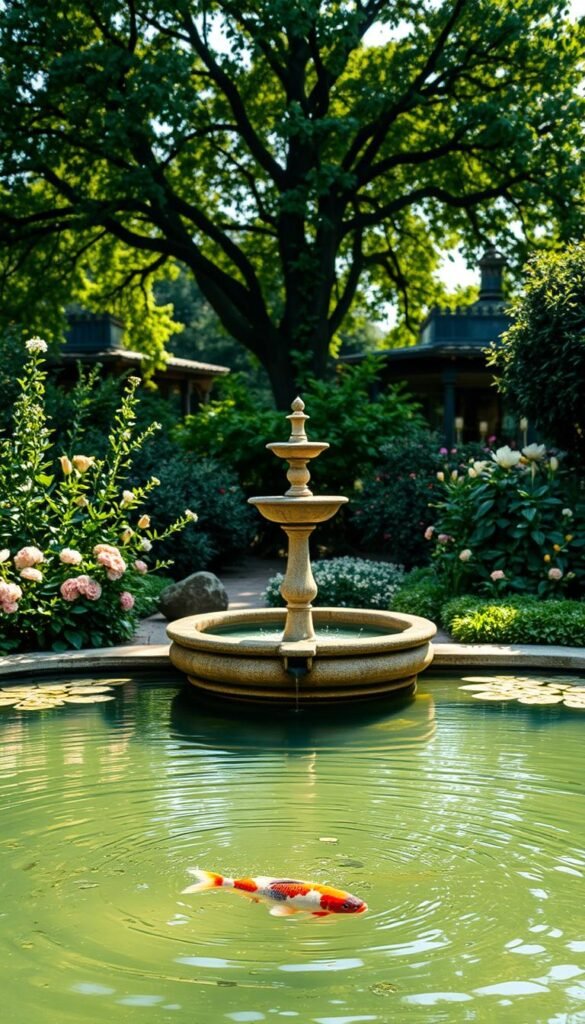
The gentle murmur of flowing water transforms outdoor areas into peaceful havens. Positioned along a central pathway or as an endpoint to framed views, water features become natural anchors that guide movement while calming the mind. Their reflective surfaces amplify surrounding greenery and architectural details, doubling your landscape’s visual impact.
Classic stone fountains with brass accents offer timeless appeal. Opt for tiered designs to create vertical interest or sleek basins that mirror the sky. These elements introduce movement through cascading streams while maintaining geometric harmony with their surroundings.
Strategic placement enhances your space’s sense of balance. Install smaller versions on patios where trickling sounds mask street noise. For larger yards, consider rectangular reflecting pools that stretch sightlines. Both approaches cultivate tranquility through rhythmic water patterns.
Three placement tips maximize impact:
- Align features with existing pathways or hedgerows
- Use recirculating pumps to conserve water
- Surround basins with moisture-loving lavender or hostas
Even compact spaces benefit from wall-mounted spouts or birdbaths. These scaled-down versions deliver auditory charm without overwhelming tight layouts. The result? A serene retreat where light dances on liquid surfaces and every ripple reinforces your design’s quiet elegance.
Choosing Elegant Garden Furniture and Decor
Your outdoor furniture sets the tone for timeless sophistication. Pieces that blend artistry with practicality create spaces where memories unfold naturally.
Materials That Tell a Story
Wrought iron from Arras showcases masterful craftsmanship. Look for curved legs ending in hoof-shaped feet—a signature detail adding romantic charm. These durable pieces weather beautifully, developing a patina that enhances their character.
Marble-topped bistro tables offer portable beauty. Their sturdy iron bases anchor seating areas without sacrificing mobility. For earthy texture, faux bois cement benches mimic weathered wood while outlasting organic materials.
Mix materials to layer visual interest. Pair iron chairs with stone side tables, or place faux bois stools beside flowering shrubs. This approach balances style with functionality, letting your garden feel curated yet relaxed.

